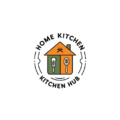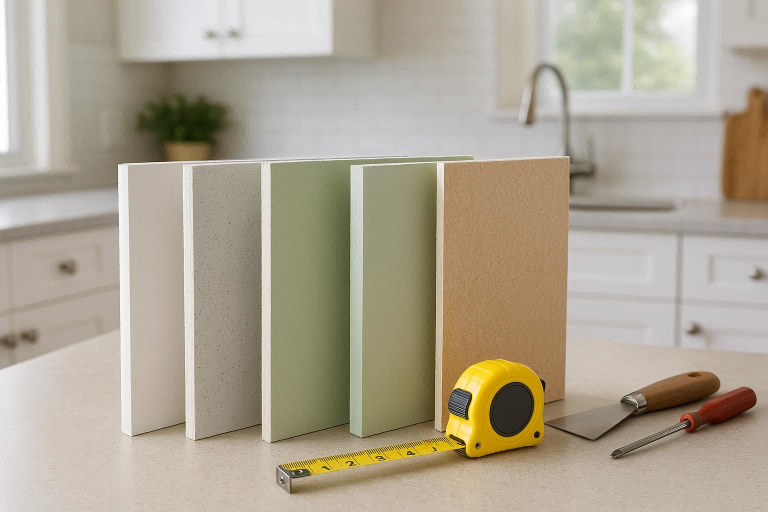When renovating or building a home, drywall is one of the most important materials used in construction. While many people are familiar with drywall, they might not realize that there are different types of drywall suited for different environments. One of the areas that require special consideration is the kitchen. In this blog post, we’ll dive deep into which drywall is best suited for the kitchen and why it’s crucial to choose the right type.
What is Drywall and Why is It Important in Kitchens?
Definition and Function of Drywall
Drywall, also known as gypsum board or plasterboard, is a construction material used to create walls and ceilings. It’s made from a layer of gypsum sandwiched between two layers of thick paper. Drywall is a common choice in construction because it’s cost-effective, easy to install, and provides a Cleaning Guide for Home & Kitchen smooth surface for painting or wallpapering.
In homes, drywall is typically used to create the interior walls of rooms, including living rooms, bedrooms, and hallways. However, certain areas of the home, like the kitchen, require more specialized types of drywall to handle unique environmental challenges.
Why the Kitchen Requires Special Consideration
The kitchen is an area with high moisture, heat, and humidity. Cooking, washing dishes, and cleaning with water creates a humid environment that can cause regular drywall to degrade quickly. Since the kitchen sees a lot of action, it’s essential to choose drywall that can withstand these conditions.
Drywall in the kitchen must be durable enough to endure moisture from cooking, splashes from sinks, and the steam from dishwashers. Additionally, safety is a big concern in the kitchen, especially near stoves and ovens. For these reasons, it’s crucial to choose drywall that is not only durable but also safe and functional.
Types of Drywall and Their Suitability for Kitchen Use
There are various types of drywall available, and each one is suited for specific environments. Let’s explore the different types and their suitability for kitchen use.
Standard Drywall (Regular Gypsum Board)
Standard drywall is the most common type used for walls and ceilings in dry areas like bedrooms and living rooms. It’s affordable, easy to install, and provides a smooth surface for painting.
Pros:
- Cost-effective
- Easy to install
- Good for dry areas
Cons:
- Not suitable for areas with high moisture or humidity
- Prone to mold and mildew growth in damp environments
Suitability for Kitchens: Standard drywall is not the best option for kitchens, especially around sinks, dishwashers, or stoves. It can absorb moisture, leading to mold growth and degradation of the drywall over time.
Moisture-Resistant Drywall (Green Board)
Moisture-resistant drywall, often called green board due to its distinctive green color, is designed to resist the absorption of moisture. It’s commonly used in bathrooms and kitchens where humidity is high.
What Makes It Moisture-Resistant?
Green board has a special coating that prevents moisture from seeping into the gypsum material. While it’s more resistant to moisture than standard drywall, it is not entirely waterproof.
Benefits for Kitchens with High Humidity:
- Resistant to moisture and steam from cooking
- Ideal for areas where water splashes are frequent, like around sinks and dishwashers
Limitations and Considerations:
While green board is better for kitchens than regular drywall, it may still suffer from mold growth if exposed to excessive moisture over time. It’s essential to install it in areas where moisture is a concern but not directly in contact with water.
Mold-Resistant Drywall
Mold-resistant drywall is a step up from moisture-resistant drywall. It’s designed specifically to prevent mold growth, making it an excellent choice for kitchens where high humidity is a problem.
Difference Between Moisture-Resistant and Mold-Resistant Drywall:
- Moisture-resistant drywall resists water absorption but doesn’t prevent mold growth completely.
- Mold-resistant drywall incorporates special additives that resist mold and mildew growth even when exposed to moisture.
Why Mold-Resistant Drywall is Ideal for Kitchens:
- Protects against mold and mildew, which are common in humid environments like kitchens.
- Perfect for installation around sinks, dishwashers, and other high-moisture areas.
- Provides extra peace of mind knowing your kitchen walls won’t harbor mold.
Fire-Resistant Drywall (Type X)
Fire-resistant drywall, also known as Type X drywall, is treated with fire-resistant materials to slow down the spread of flames in the event of a fire.
Purpose and Benefits in Fire-Prone Areas Like Kitchens:
- Fire-resistant drywall helps contain fires, providing valuable extra minutes in case of a kitchen fire.
- Especially important near stoves, ovens, and other heat-producing appliances.
How It Improves Kitchen Safety:
- It helps delay the spread of fires, giving you more time to evacuate or put out the fire.
- Ideal for kitchen walls adjacent to stoves, ovens, and other high-temperature areas.
How to Choose the Right Drywall for Your Kitchen?
Choosing the right drywall for your kitchen depends on several factors. Let’s explore the most important considerations to make an informed decision.
Consider the Kitchen Environment
Your kitchen’s environment is unique because of the high levels of moisture, heat, and temperature fluctuations. The areas closest to the sink, stove, and dishwasher require more moisture-resistant drywall to prevent damage.
For example, the walls near the stove are more exposed to heat and steam, while the walls near the sink and dishwasher are exposed to water splashes. Choosing the appropriate drywall for each of these areas can make a significant difference in the durability and longevity of your kitchen walls.
Durability and Longevity
The kitchen is a high-traffic area, and walls are often exposed to wear and tear. Choosing durable drywall ensures that your kitchen walls remain intact and functional for many years. If your kitchen is prone to a lot of moisture or heat, opt for mold-resistant or fire-resistant drywall to improve longevity.
Budget Considerations
Drywall prices can vary based on the type and quality. While standard drywall is the least expensive, it’s not the best choice for a kitchen. Moisture-resistant and mold-resistant drywall options might cost more upfront, but they can save you money in the long run by preventing damage and the need for costly repairs.
Installation Tips for Kitchen Drywall
Proper installation is key to ensuring the drywall in your kitchen remains effective for years to come. Here are some tips to consider:
Proper Ventilation During Installation
Good ventilation is essential when installing drywall in kitchens. Ensure that the area is well-ventilated to prevent moisture build-up during installation, which can lead to mold growth.
Sealing and Waterproofing
After drywall installation, it’s crucial to seal all joints and seams properly to prevent water from getting behind the drywall. Use a high-quality sealant to ensure a watertight finish.
Installing in High-Moisture Zones
For areas around the sink, stove, and dishwasher, make sure to use moisture-resistant or mold-resistant drywall. In particularly high-moisture zones, consider applying a waterproof membrane behind the drywall for extra protection.
Common Mistakes to Avoid When Installing Kitchen Drywall
Installing drywall in the kitchen isn’t a simple task, and there are several common mistakes to avoid.
Using the Wrong Type of Drywall
Using standard drywall in a kitchen is a mistake, especially in areas prone to moisture or heat. It’s essential to choose moisture-resistant or mold-resistant drywall for durability.
Not Sealing the Drywall Properly
Failing to properly seal the drywall seams can lead to water seepage, which can cause damage and mold growth. Always use high-quality sealant around edges and seams.
Ignoring Moisture Control
Improper moisture control can lead to long-term damage to your kitchen walls. Make sure to use the right type of drywall and ensure proper ventilation and sealing to keep moisture at bay.
Benefits of Choosing the Right Drywall for Your Kitchen
Choosing the correct drywall for your kitchen can have several benefits that improve the overall quality and safety of your space.
Enhanced Durability and Safety
By selecting the right drywall, such as mold-resistant or fire-resistant drywall, you’ll improve the durability of your kitchen walls while ensuring safety in the event of a fire or moisture-related issues.
Improved Aesthetic Appeal
The right drywall not only protects your walls but also contributes to the overall design of your kitchen. Smooth, well-maintained drywall enhances the look of your kitchen, whether you’re painting the walls or adding decorative finishes.
Cost-Effectiveness in the Long Run
While high-quality drywall options like mold-resistant and fire-resistant types might be more expensive initially, they offer long-term savings by preventing costly repairs due to water damage, mold growth, or fire-related issues.
FAQ
What type of drywall is best for high-humidity kitchens?
Moisture-resistant or mold-resistant drywall is best suited for high-humidity kitchens, as it prevents mold growth and moisture damage.
Can I use regular drywall in the kitchen?
Regular drywall is not recommended for kitchens with high moisture or heat. It can absorb moisture, leading to mold and mildew growth.
How do I know if my kitchen needs mold-resistant drywall?
If your kitchen experiences high humidity or is prone to dampness, mold-resistant drywall is ideal to prevent mold growth.
What’s the difference between moisture-resistant drywall and mold-resistant drywall?
Moisture-resistant drywall is designed to handle dampness but can still be susceptible to mold, while mold-resistant drywall includes special additives to prevent mold and mildew growth.
Is fire-resistant drywall necessary in the kitchen?
Fire-resistant drywall can provide additional protection, especially near stoves, ovens, and other high-heat areas. It slows down the spread of flames, giving you more time to react in case of a fire.
Can I install drywall myself in the kitchen?
DIY installation is possible but requires knowledge of proper sealing, moisture control, and ventilation. Improper installation can lead to moisture issues and long-term damage.
How much does drywall installation cost for a kitchen?
The cost depends on the type of drywall, labor, and installation complexity. Moisture-resistant or mold-resistant drywall may cost slightly more than standard drywall, but it is worth the investment.
Conclusion
Choosing the right drywall for your kitchen is crucial to maintaining a safe, durable, and aesthetically pleasing space. By selecting moisture-resistant, mold-resistant, or fire-resistant drywall, you’ll ensure that your kitchen stands up to the challenges of high humidity, heat, and moisture. Make an informed decision and invest in the right drywall to enjoy a long-lasting, functional kitchen.

